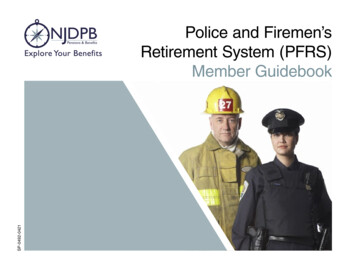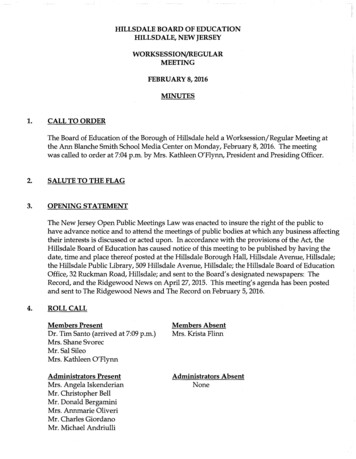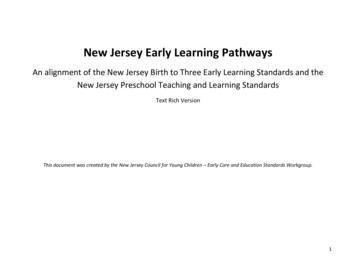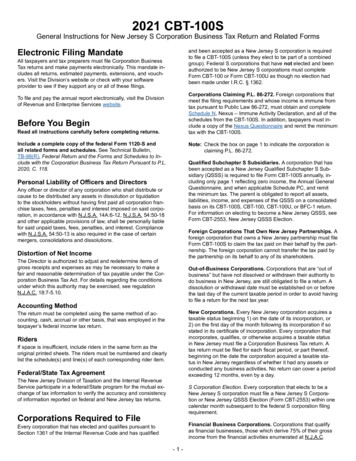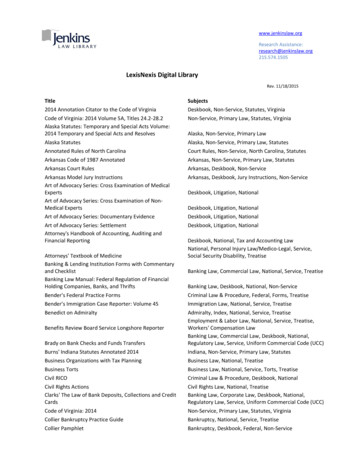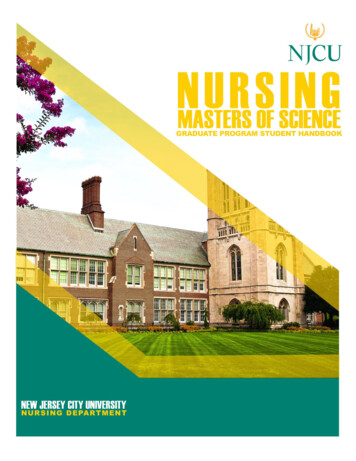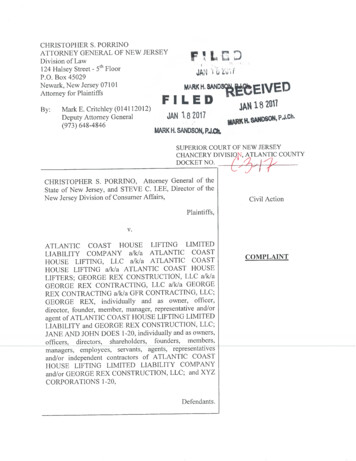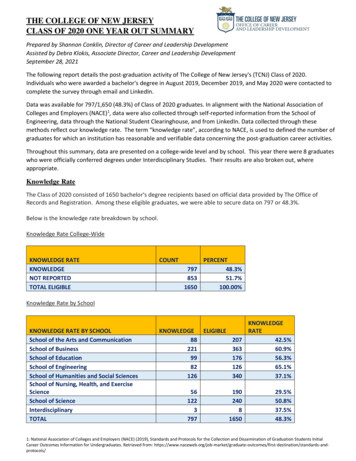
Transcription
THE COLLEGE OF NEW JERSEYCLASS OF 2020 ONE YEAR OUT SUMMARYPrepared by Shannon Conklin, Director of Career and Leadership DevelopmentAssisted by Debra Klokis, Associate Director, Career and Leadership DevelopmentSeptember 28, 2021The following report details the post-graduation activity of The College of New Jersey's (TCNJ) Class of 2020.Individuals who were awarded a bachelor's degree in August 2019, December 2019, and May 2020 were contacted tocomplete the survey through email and LinkedIn.Data was available for 797/1,650 (48.3%) of Class of 2020 graduates. In alignment with the National Association ofColleges and Employers (NACE)1, data were also collected through self-reported information from the School ofEngineering, data through the National Student Clearinghouse, and from LinkedIn. Data collected through thesemethods reflect our knowledge rate. The term “knowledge rate”, according to NACE, is used to defined the number ofgraduates for which an institution has reasonable and verifiable data concerning the post-graduation career activities.Throughout this summary, data are presented on a college-wide level and by school. This year there were 8 graduateswho were officially conferred degrees under Interdisciplinary Studies. Their results are also broken out, whereappropriate.Knowledge RateThe Class of 2020 consisted of 1650 bachelor's degree recipients based on official data provided by The Office ofRecords and Registration. Among these eligible graduates, we were able to secure data on 797 or 48.3%.Below is the knowledge rate breakdown by school.Knowledge Rate College-WideKNOWLEDGE RATEKNOWLEDGENOT REPORTEDTOTAL wledge Rate by SchoolKNOWLEDGE RATE BY SCHOOLSchool of the Arts and CommunicationSchool of BusinessSchool of EducationSchool of EngineeringSchool of Humanities and Social SciencesSchool of Nursing, Health, and ExerciseScienceSchool of ScienceInterdisciplinaryTOTALKNOWLEDGEKNOWLEDGE 8.3%1: National Association of Colleges and Employers (NACE) (2019), Standards and Protocols for the Collection and Dissemination of Graduation Students InitialCareer Outcomes Information for Undergraduates. Retrieved from: es/first-destination/standards-andprotocols/
Outcome RateThe percentages in this section are based on the 797 graduates for which we have data. As a result of the informationobtained, employment, continuing education, military, and volunteer outcomes are available for 92.7% (739/797) ofthe Class of 2020. The group with confirmed plans define the term "Outcome Rate". We opted to use the term"Continuing Education" to align with NACE Standards and Protocols for the Collection and Dissemination ofGraduation Students Initial Career Outcomes Information for Undergraduates (2019). Accordingly, continuingeducation defines "those who have been accepted to and plan to matriculate into a program of further study. Thisincludes graduate school or specialized training", (NACE, 2019, pg.7). Data indicates 0.1% (1/797) are not employedand not searching for a job; this group constitutes those defined as "Not Seeking". Data also shows 7.2% (57/797) arenot employed and currently searching for a job; this group constitutes those defined as "Still Seeking".Outcome Rate by College-WideOUTCOME RATEOUTCOMESTILL SEEKINGNOT SEEKINGGrand tcome Rate by SchoolOUTCOMERATE BYSCHOOL COUNTOUTCOMESTILL SEEKINGNOT 0%Arts g98.8%1.2%0.0%100.0%Humanities& 00.0%561223Primary OutcomeClass of 2020 graduates were asked to indicate their primary plans after graduation within the first year aftergraduation. Below is the breakdown of those plans across TCNJ as a whole, as well school based on the 797respondents. The term "employed" refers to students indicating full-time or part-time employment, "continuingeducation" refers to students pursuing graduate or professional school, or further study (i.e. certificate), "military"refers to students pursuing military service, “volunteer” refers to those participating in a volunteer or service program(i.e. Peace Corps of AmeriCorps), "not seeking" refers to students not attending graduate school nor seekingemployment, "still seeking" refers to students actively searching for employment.Primary Outcome by SchoolPRIMARY OUTCOME COLLEGE-WIDEEMPLOYEDCONTINUING EDUCATIONSTILL SEEKINGVOLUNTEERNOT SEEKINGMILITARYGrand 5%0.1%0.1%100.0%2
Primary Outcome by SchoolPRIMARYOUTCOME BYSCHOOLTCNJ-WIDEArts es& .4%14.6%35.7%21.4%24.6%33.3%STILL TEER0.4%0.0%0.0%0.0%0.0%0.8%1.8%0.8%0.0%NOT YTOTALRESPONSE 2219982126561223Employment TrendsAmong the 797 respondents, 576, or 72.8%, reported employment as their primary outcome and 551, or 95.6%reported full-time employment. Throughout this section are details on the employment trends of the Class of 2020reporting full-time employment.Top EmployersAll 551 graduates employed full-time reported employer information, which includes 426 unique organizations acrossthe education, healthcare and services, financial services, pharmaceutical, manufacturing, government, consulting,media and entertainment, and other industries. Below are employers hiring 3 or more graduates.EMPLOYER NAMEAT&TAtlantic Health SystemBarclaysBordentown Regional SchoolDeloitteEisnerAmper LLPEY LLPHamilton Township School District - Mercer CountyHardesty & HanoverHopewell Valley Regional School DistrictInternational Planning AllianceIQVIAJPMorgan Chase & Co.KiewitKPMG LLPLockheed MartinMerck & Co., Inc.MJH Life SciencesNielsenPenn MedicinePricewaterhouseCoopers (PwC)Prudential FinancialTabula Rasa HealthcareWhiting-Turner Contracting CompanyEmployer Industry BreakdownBelow is the breakdown of the 551 graduates reporting full-time employment and their employer organization’s industry. The topthree industries include financial services (accounting, investment banking, insurance, and commercial banking), education (K-12education, higher education, and other education), and healthcare and services (healthcare and social assistance).3
Employer Industry Breakdown (continued)EMPLOYED FT INDUSTRIES BY SCHOOLFinancial ServicesEducationHealthcare & ServicesArchitecture, Real Estate &ConstructionTechnologyMedia & MarketingGovernment, Law & PoliticsPharma & Medical DevicesProfessional ServicesOther IndustriesManufacturingFood, Beverage & CPGArts, Entertainment & RecreationNon-ProfitRetail Stores & TradeEnergyHospitalityTransportation & LogisticsAgriculture & Natural ResourcesGrand TotalResponse CountGrand d Full-Time Salary and Offer Trends College-WideAmong the 551 reporting full-time employment, 290 reported their salary. Below is the average based on allreporting, as well as the median based on the 50th percentile. The Class of 2020 salary median of 57,720 remainsconsistent with the Class of 2019 median salary, which was 57,500. 265 graduates reported the number of offersreceived for full-time employment, where 56.9% received two or more offers. Compared to Class of 2019, where 63%received two or more offers, this is a 6.1% decline, but aligns with Class of 2018, where 56% received two or more joboffers.SALARY TRENDS TCNJ-WIDESalary AverageSalary MedianSalary RangeSalary Report CountEMPLOYED FULL-TIMEOFFER COUNTOne (1)Two (2)Three (3)Four (4) or MoreGrand TotalTCNJ-Wide 56,819 57,720 16,640 - .8%100.0%4
Employed Full-Time Salary and Offer Trends by SchoolSALARYTRENDS BYSCHOOLSalary AverageSalary MedianArts &Communication 49,140 50,000 16,640 Salary Range 100,000Salary ReportCount34Percent ofEmployed FTReportingSalary50.0%*Not included since less than 3reportedEMPLOYED FULLTIME OFFERCOUNT BYSCHOOLBusiness 59,500 61,000 24,000 90,000Education 54,335 55,000Engineering 66,756 65,000Humanities& SocialSciences 42,978 40,000 21,153 87,360 31,200 91,000 23,504 63,000Nursing,Health &ExerciseScience 62,995 60,160 24,960 .7%100.0%52.6%ScienceTCNJ-WideHumanities& SocialSciencesScience 57,524 52,105 17,000 90,000SelfDesigned*N/AN/ATCNJ-Wide 56,819 57,720 16,640 105,000Arts &CommunicationBusinessEducationEngineeringNursing, Health &Exercise ScienceOne (1)41.2%37.8%37.9%42.9%50.0%52.0%45.9%43.0%Two (2)Three .1%44.0%4.0%32.4%10.8%35.8%14.3%Four (4) or MoreGrand 100.0%0.0%100.0%10.8%100.0%6.8%100.0%Response Count34742928382537265Employed Full-Time Relation to Undergraduate Major/Area of StudyAmong those in full-time roles, 265 provided information regarding the relationship between their undergraduatemajor and their current position. 74% (196/265) reported direct relation, an increase compared to Class of 2019 where58.7% (193/329) reported direct relation. Additionally, 21.5% (57/265) reported indirect relation, and 4.5% (12/265)reported no relation.EMPLOYED ROLERELATION TOMAJORDirectly RelatedIndirectlyRelatedArts Health &ExerciseScienceHumanities &Social %Not Related0.0%4.1%0.0%0.0%15.8%4.0%5.4%4.5%Grand .0%34742928382537265Response Count5
Continuing Education TrendsAmong the 797 respondents, 158, or 19.8%, reported continuing education as their primary outcome. Throughout thissection are details on the continuing education and graduate schools trends of the Class of 2020. The data in thissection reflects information received from the National Student Clearinghouse, in addition to self-reportedinformation.CONTINUINGEDUCATIONBY SCHOOLArts onEngineeringHumanities& .6%35.7%21.4%24.6%33.3%Continuing Education Degree Level158 reported their degree level for their program of continuing education. 98.1% (155/158) are enrolled in a master'sor doctoral degree program. The other degrees where graduates are enrolled include 0.6% (1/158) in a non-degreeseeking program and 0.6% (1/158) in a bachelor's program.DEGREE LEVELBY and TotalResponse .1%Arts 100.0%0.0%Engineering66.7%33.3%Humanities& .0%0.0%33.3%100.0%6.7%100.0%0.0%100.0%Continuing Education Area of Study157 of 158 reported their major/area of study for continuing education.CE AREA ScienceSocialSciencesGrand TotalTCNJWide0.6%5.1%27.4%7.0%9.6%17.8%6.4%Arts 0%16.7%0.0%Humanities& 100.0%6
Continuing Education Program Relation to Undergraduate Major/Area of StudyAmong the 158 reporting continuing education, 90 provided information regarding the relationship between theirundergraduate major and their continuing education program area. 74.4% reported direct relation, a slight increasecompared to 72.9% from the Class of 2019 reporting direct relation.CONTINUINGEDUCATIONPROGRAMRELATION TOMAJORTCNJ-WideArts andCommunicationBusinessEducationHumanities& ienceScienceDirectly directly Related21.1%62.5%40.0%0.0%0.0%25.9%22.2%15.8%Not Related4.4%0.0%20.0%5.3%0.0%7.4%0.0%0.0%Grand .0%908519327919Response CountContinuing Education InstitutionsAll 158 graduates continuing education reported their institution name. Class of 2020 are attending 54 institutions fortheir continuing education programs. Below are the institutions where 3 or more are attending.INSTITUTIONSThe College of New JerseyRutgers UniversityRowan UniversityMontclair State UniversityStevens Institute of TechnologySeton Hall UniversityGeorgetown UniversityTemple UniversityJohns Hopkins UniversityVillanova UniversityCOUNT552375333333Future Class of 2020 ReportsAdditional Class of 2020 details will be published in October 2021, followed by school-specific reports. These reportswill include breakdowns on employers, job titles, and average salary by major, as well as continuing educationprograms and institutions by major.For questions, please contact career@tcnj.edu or visit https://career.tcnj.edu/survey-archive/7
education defines "those who have been accepted to and plan to matriculate into a program of further study. This includes graduate school or specialized training", (NACE, 2019, pg.7). Data indicates 0.1% (1/797) are not employed and not searching for a job; this group constitutes those defined as "Not Seeking". Data also shows 7.2% (57/797) are


